Industrial Agricultural Pollution 101
From fertilizer runoff to methane emissions, large-scale industrial agriculture pollution takes a toll on the environment.
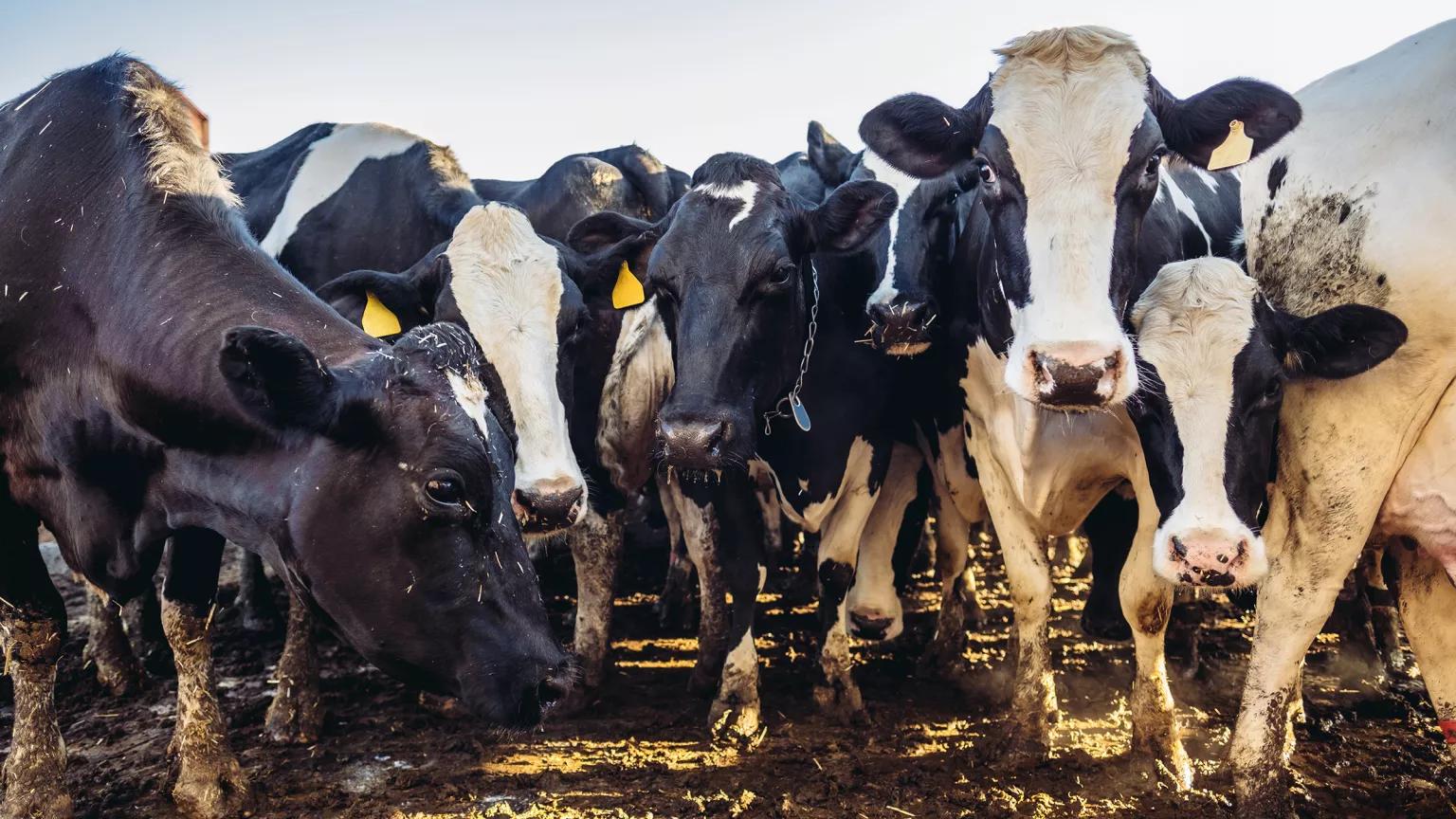
A herd of dairy cows stand in a corral on a farm outside Salt Lake City, Utah.
iStock
Agriculture—including how we grow, raise, transport, process, and even store food and nonfood crops and agriculture products—has a profound effect on the planet. Think of what it takes to feed, for example, the roughly 10 billion animals raised for food each year in the United States. Or what goes into growing this country’s 92.7 million acres of corn, used mainly for livestock feed and ethanol production. The monumental quantities of fertilizers and pesticides that go into those operations (and all the manure that comes out) are just a few examples of the pollution associated with agriculture. Here’s your guide to making sense of the many and varied impacts of our farming practices.
What is agricultural pollution?
Agricultural pollution is the contamination we release into the environment as a by-product of growing and raising livestock, food crops, animal feed, and biofuel crops.
The history of industrial agriculture
For most of our history, humans were hunters and gatherers. We fished in the ocean, hunted on land, and collected wild-growing fruits, seeds, and plants. Modern agriculture was born just 12,000 years ago, when we began to grow wild wheat and barley in the Fertile Crescent of the Middle East and Mediterranean basin, and to tend the first rice paddies in the swamps of China. Agriculture transformed our way of life, giving us more consistent food supplies, allowing the growth of civilizations, and supporting an exponential boom in human population.
In the thousands of years since, agriculture has undergone tremendous horizontal growth, meaning that humans have set aside more and more land to grow food. In recent decades, we’ve also radically industrialized our methods and developed more resilient (and productive) crop species. It’s this growth in productivity—also called vertical expansion—that’s been credited with skyrocketing yields and reducing the cost of food. But many of the tools enabling this high-input, high-volume commodity agriculture have also contributed massive amounts of agricultural pollution.
What are the causes of agricultural pollution?
For most of history, meat was considered a luxury. But as disposable income has risen in the past century, so too has our demand for and consumption of meat, dairy, and eggs. Between 1961 and 2014, meat consumption around the globe doubled, from an average of 44 pounds per person each year to 95 pounds. Americans now consume even more: an estimated 225 pounds of red meat and poultry per person annually in 2022, according to the U.S. Department of Agriculture (USDA). Here’s why feeding, slaughtering, and transporting billions of animals each year, in businesses known as concentrated animal feeding operations (CAFOs), is environmentally costly.
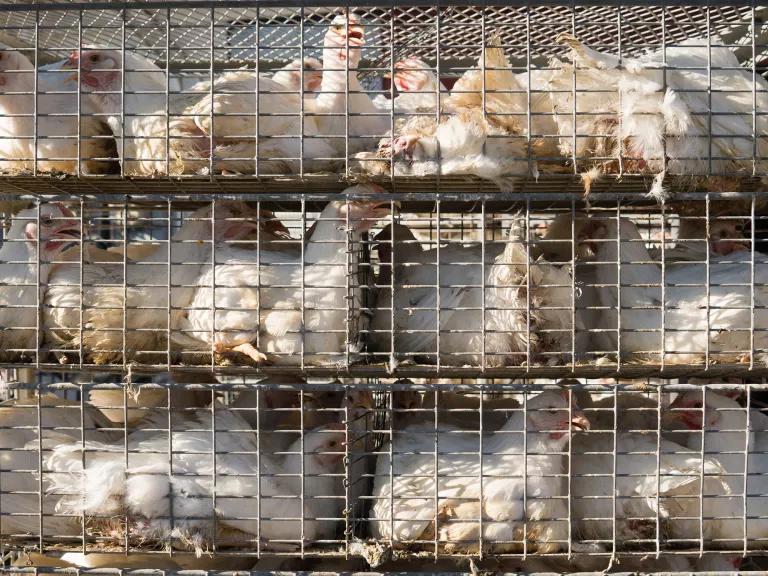
ChrisBoswell/Getty
Livestock water pollution
Cows, pigs, chickens, and turkeys do what all other animals do: poop. According to the USDA's Agricultural Research Service, livestock and poultry grown in the United States produce nearly 1.4 billion tons of manure annually, or almost five times the waste of the entire U.S. population. All of that farm animal waste needs to go somewhere. But CAFOs don’t treat animal waste in the same way we treat human waste, by sending it to a wastewater treatment plant via a municipal sewer system.
Instead, this waste is disposed of by spreading it, untreated, on land. Operators are supposed to apply only the amount that crops can use, but in reality, there is often too much manure—so it is applied beyond the ground’s natural absorption rate, leading to runoff into water sources. To make matters worse, before it is applied to land, the manure usually sits on-site in vast manure lagoons that can grow to the size of a football field. The lagoons contain a toxic stew of antibiotics residue, chemicals, and bacteria decomposing the waste, a medley that can take on a sickly hue. They’re often unlined and are prone to overflows, leaks, and spills, causing the contents to leach into the soil and groundwater. (Big storms like Hurricane Florence, which devastated North Carolina’s coast, make wide-scale spills and contamination even more likely.) And once this mixture, chock-full of phosphorus and nitrogen, gets into a waterbody, it causes a cascading reaction called eutrophication, or the destructive overgrowth of algae.
Similar problems arise with poultry waste, which is mostly dry litter—a combination of the birds’ bedding materials (such as shavings), their feces, and loose feathers—that is stored in exposed, giant mounds. Because chicken manure contains a higher percentage of phosphorus than other animal manure, it’s also prone to harming waterways with phosphorus runoff.
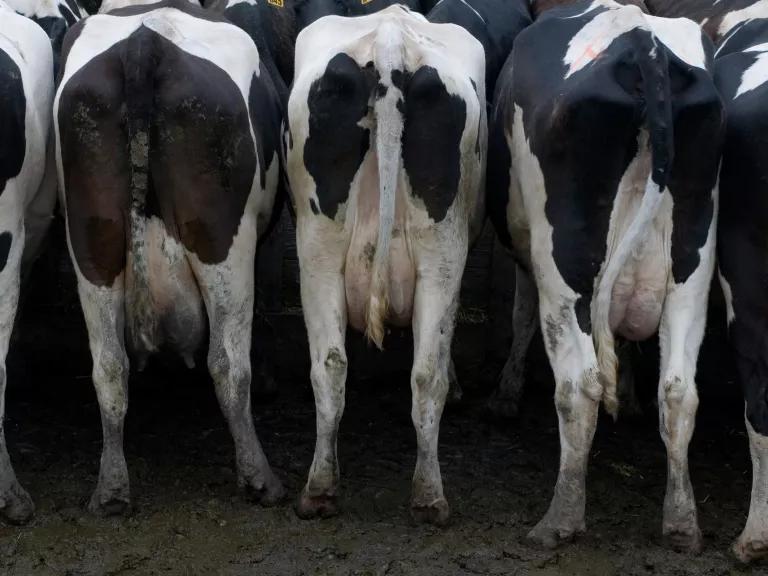
iStock
Livestock air pollution
Livestock and their manure pollute our air too: According to the EPA, manure management alone accounts for 12 percent of all agricultural greenhouse gas emissions in the United States; globally, it accounts for 14.5 percent, according to the United Nations' Food and Agriculture Organization. Manure emits ammonia that then combines with other air pollutants, like nitrogen oxides and sulfates, to create tiny—and deadly—solid particles. We humans inhale these particles, which can cause heart and lung diseases and are said to account for at least 3.3 million deaths each year globally, says a 2016 study from the journal Geophysical Research Letters. In the United States, they account for 17,900 deaths as of 2021. Additionally, hog waste in particular has been called out by people living near CAFOs for its foul smell.
Antibiotic resistance
The widespread use of antibiotics in the meat production of animals that are not sick is contributing to the public health crisis of antibiotic resistance. Nearly two-thirds of antibiotics important to human medicine in the United States are sold for use in livestock, not people. The regular use of these drugs in the food and water of farm animals to (poorly) help them survive the often crowded, unsanitary, and stressful conditions at CAFOs contributes to the rise and proliferation of antibiotic-resistant bacteria. These bacteria can then spread from CAFOs via air and water, including water used to irrigate crops, and can end up in animal waste used to fertilize crops. Contaminated meat and farmworkers’ clothing and shoes can also spread these antibiotic-resistant bacteria into our communities. Resistant bacteria can even “teach” resistance to other bacteria, and this process can take place anywhere bacteria are found, including in our homes and our guts. The exposure for workers and farm-adjacent communities is particularly high.
Antibiotic-resistant bacteria are among the gravest health threats we face today. A 2022 study published in The Lancet estimated that 1.27 million people per year die worldwide as a direct result of antibiotic-resistant infections, and such bacteria also played a role in a total of 4.95 million deaths. And public health officials warn that the crisis will only get worse if we continue misusing and overusing these drugs.
Crop agriculture pollution
Industrial agriculture allows us to overproduce grains, fruits, and vegetables year-round (although about 38 percent of the planet’s arable land is used just for grazing livestock and growing their feed). Unfortunately, this productivity comes with a price.
Nitrogen-based fertilizers
Nitrogen-based fertilizer has been a major factor driving the industrialization of agriculture in the past century, allowing high yields, even on overtaxed land. But fertilizer has serious downsides for our water supplies and climate.
Nitrogen is a primary building block for plants, and healthy soil uses nitrogen efficiently. But under monocropping, the soil becomes depleted of nutrients, requiring farmers to try to regenerate the soil through practices like planting cover crops or, failing that, to move on to more arable land. The invention of synthetic nitrogen in the 20th century (and then, quickly, its skyrocketing use) removed this limiting factor and allowed for a boom in chemical-intensive, industrial farming practices. A big boom, indeed: In 1964, U.S. farmers applied about 4.3 million tons of nitrogen to their crops each year. According to the EPA, by 2018, it had doubled to about 8 million tons of nitrogen, not including potash or phosphate fertilizers, being used across the country’s major agricultural regions.
Synthetic forms of nitrogen are different in some key ways from the nitrogen occurring naturally in our atmosphere. Naturally occurring nitrogen, known as N2, is more difficult for plants to use, requiring specific bacteria to help make it bioavailable. But synthetic fertilizer is made up of a nitrogen-and-hydrogen-based ammonia (NH3) that can be used by plants directly. Transforming N2 into NH3 through chemical processes is resource-intensive, and this form of nitrogen is also more prone to reacting with other things in the environment, not just plants.
In addition, when excess nitrogen makes its way into the atmosphere (as it often does when fertilizer is applied at high volumes), it can become nitrous oxide, a potent greenhouse gas, or nitrogen oxide, which contributes to ground-level smog.
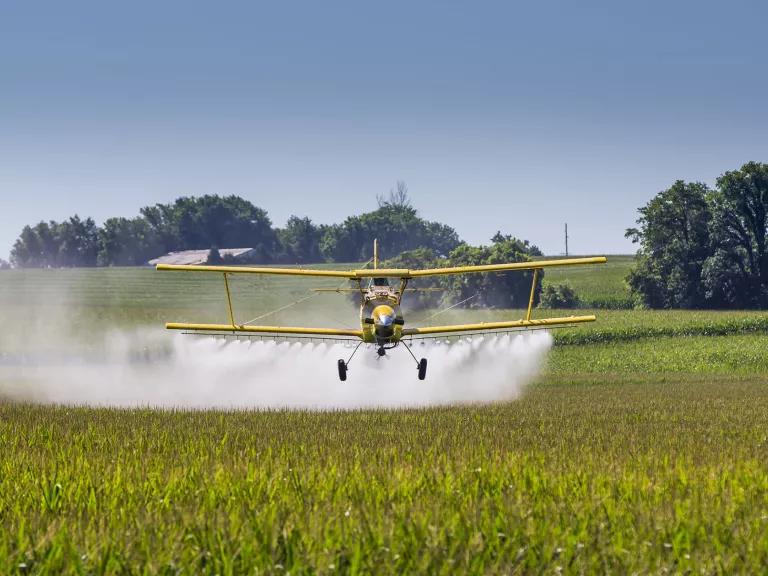
A crop duster sprays fertilizer over a large field.
123RF
Nutrient runoff
The climate impacts alone are enough of a reason to wean ourselves off synthetic fertilizers, but these chemicals have another major environmental downside: nutrient runoff. Runoff occurs when nutrient-rich material like fertilizer or manure, chock-full of nitrogen and phosphorus, makes its way into nearby rivers, oceans, and lakes, wreaking havoc on our freshwater and marine ecosystems. Heavy rains can trigger runoff, as can soil erosion. Here’s how it works: An excess of nutrients in a water system causes an overgrowth of algae. As algae die off, aerobic bacteria decompose them, consuming oxygen in the process and starving other marine life. Algae overgrowth can also block sunlight, disrupting the ecosystem below the water surface that relies on the sun for energy.
The results can be dramatic: Nutrient runoff decimated the once-thriving Chesapeake Bay, killing off large numbers of the estuary’s fish and shellfish. Each summer, high levels of manure and fertilizer from the Mississippi River make their way into the Gulf of Mexico, causing a recurring “dead zone” thousands of miles wide. And in recent years, persistent algal blooms, like red tides that produce toxins, have devastated coastal communities in Florida, staying long past their typical seasons and killing marine life en masse.
Pollution via runoff (known as agricultural nonpoint source pollution) is the leading source of harm to water quality for surveyed rivers and streams, the third-largest for lakes, and the second-largest for wetlands; for oceans, it’s estimated that a whopping 80 percent of marine pollution comes from the land. But stemming it is within our control. Farmers can significantly reduce nutrient runoff by following fertilizer best practices, as well as adopting regenerative agriculture strategies, such as improving soil health through planting cover crops and improving water quality by planting streamside buffer crops.
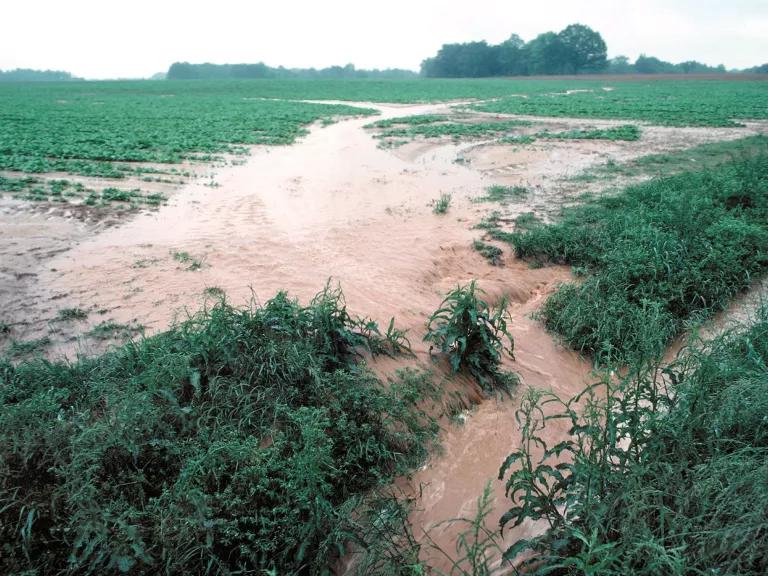
Muddy water runs off a farm field in Tennessee following a storm.
Tim McCabe/USDA
Chemical pesticides
Farmers routinely use pesticides—herbicides, insecticides, rodenticides, and fungicides—to keep away any unwanted weeds, insects, rodents, and fungi. But these toxic chemicals have serious side effects. These chemicals can cause many chronic diseases such as endocrine (hormone) and neurological disorders and cancer. Because of their still-developing bodies, children are especially vulnerable to exposure and face the worst health impacts. Some of the most toxic pesticides, like chlorpyrifos, have been linked to developmental delays, lower IQs, and learning disabilities.
Since becoming widespread in the past century, pesticides are routinely detected in 88 percent of our streams and rivers, according to the U.S. Geological Survey. More than 90 percent of Americans have pesticides in our bodies, circulating to all the organs and systems, where they can cause adverse health effects. Farmworkers are particularly susceptible to exposure, coming into contact with pesticides when spraying fields, inhaling pesticide “drift,” and exposing their families via contamination on their clothing. Rural residents in general may be exposed to contaminated water, air, and food.
Aside from being bad for human health, pesticides like neonics are also bad for pollinators. The populations of insects, such as the iconic monarch butterfly and native bees like the rusty-patched bumble bee, have plummeted in recent decades, due in part to these ubiquitous toxins. But under pressure from pesticide manufacturers and industry lobbyists, governments are often slow to ban or even limit these products’ use. Instead they choose to pass off the risk to consumers, rural communities, and agricultural workers.
The carbon footprint of meat
If we’re going to stave off the worst effects of climate change, we must tackle the oversize carbon pollution footprint of meat. Currently, according to the EPA, agriculture accounts for about 11 percent of U.S. emissions, and of that, 36 percent comes from the raising, feeding, and management of livestock.
Enteric fermentation
It’s a fancy name for a not-so-fancy phenomenon: cow burps and gas. Enteric fermentation is part of the digestive process of ruminant animals like cows, sheep, and goats. Gut microbes decompose and ferment fibrous food, like grass, producing methane, which has 28 to 34 times the planet-warming power of carbon, according to the United Nations Economic Commission for Europe. Those emissions add up: Enteric fermentation is the largest source of greenhouse gas emissions in agricultural production, contributing nearly 179 million metric tons of carbon dioxide–equivalent emissions, per the EPA.
Caloric inefficiency
The caloric inefficiency of beef drives its high carbon price tag. It takes much more food, water, and land to produce beef than it does to produce fruits and vegetables. And livestock feed is typically grown using pesticides as well as fertilizers, both of which are made with fossil fuels. All of these factors add up to mean that meat diets produce 59 percent more greenhouse gases than vegetarian ones, according to the National Institutes of Health, with beef being 34 times more damaging to our climate than legumes like beans and lentils, by weight. Additionally, planting crops like legumes helps sequester more nitrogen in the soil, whereas composting cow manure releases more methane and nitrous oxide into the air.
Land use changes
Shifting land use to raise more livestock delivers a one-two punch to the environment. Not only is animal agriculture resource-intensive and polluting, but clearing land that previously held forest and other vegetation means releasing stored carbon into the environment and destroying diverse ecosystems. Cattle ranching, for example, is devastating the Amazon rainforest, accounting for nearly 80 percent of the deforestation in every Amazon country. And the Food and Agriculture Organization of the United Nations (FAO) has found that nearly 90 percent of deforestation globally is for agriculture—with 40 percent for livestock grazing. Protecting dense carbon sinks like this rainforest is critical to reducing our carbon emissions and fighting climate change.
Reducing industrial agriculture pollution
By 2050, the United Nations estimates that the global population will hit nearly 10 billion. Can we feed all these people without overtaxing our natural resources or destroying the planet in the process? It’s possible, but we’ll have to make significant shifts in the way we grow, raise, and eat food. Here are some steps we can all take, and even small changes can be very meaningful:
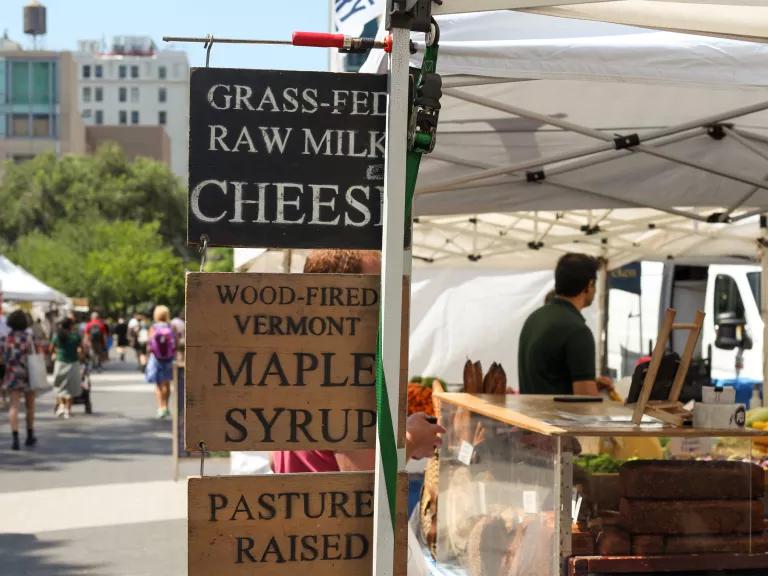
A vendor’s sign in a farmers’ market
Soné Keith for NRDC
- Eat more plant-based foods.
- Minimize consumption of red meat, our most carbon-intensive food.
- When choosing among restaurants, consider their records on antibiotic use in their meat supply (check out NRDC’s restaurant scorecards).
- When you buy animal products, buy products from animals raised without the regular use of medically important antibiotics. Look for any of these labels: American Grassfed, Animal Welfare Approved, Certified Humane, Global Animal Partnership (GAP), USDA Certified Organic, and USDA Process Verified No Antibiotics Ever. All of these indicate third-party certification. Labels saying “no antibiotics administered,” “no antibiotics added,” or “raised without antibiotics” also communicate the producer’s commitment to responsible use but they are not verified by an outside group.
- When possible, opt for organic, especially with the fruits and vegetables known to carry the highest amounts of pesticides like strawberries, spinach, and apples.
- Plan meals in advance and serve small portions to prevent food waste, a significant contributor of greenhouse gases. Nearly 40 percent of food in America goes uneaten, a remarkable waste of resources.
- Don’t trash food scraps. Bring leftovers home from restaurants, and freeze what you won’t eat right away. Any vegetable odds and ends can go into a home or community compost.
- Support local farmers practicing more sustainable growing methods by buying from a neighborhood market. Get to know the farmers, ask about their soil and livestock management practices, and let them know you appreciate their efforts.
- Buy “ugly” produce. Food waste happens at every level of the supply chain—including on the farm itself. Edible produce is frequently left unharvested because there’s simply no market for it. (Think tiny apples, misshapen carrots, or too much of any one crop.) Though farm-level food waste is the least destructive kind (as resources have not been expended on packing and shipping), we can still do our part by telling local farmers directly that we’re willing to purchase imperfect produce, which could help shape future harvesting practices.
- Buy in bulk to limit your packaging consumption but be aware of food waste and only buy what you can finish.
- Start a “plant forward” initiative in your community and build meals around your favorite vegetables instead of meats.
- Grow your own food, without chemicals. You’ll have a better understanding of regenerative farming and will be able to reward yourself with organic, in-season produce.
- Pay attention to farm policy and be vocal in your support of pro-environment practices. While the solutions for reducing nutrient pollution are plentiful, our system of food and farm policies is not set up to give farmers incentives to use the best practices. In fact, farm policy is often a barrier to practices that regenerate the land. You can make a difference by reading up on farm policy in the news and petitioning your government representatives to do the following: support conservation and climate-friendly farming; ban harmful pesticides; reduce the use of medically important antibiotics in meat and poultry production; improve the crop insurance program; invest in research to help farmers transition away from chemical agriculture to more ecological practices like organic and regenerative farming; and enforce stricter rules on the disposal of manure from CAFOs.
This story was originally published on July 31, 2019, and has been updated with new information and links.
This NRDC.org story is available for online republication by news media outlets or nonprofits under these conditions: The writer(s) must be credited with a byline; you must note prominently that the story was originally published by NRDC.org and link to the original; the story cannot be edited (beyond simple things such as grammar); you can’t resell the story in any form or grant republishing rights to other outlets; you can’t republish our material wholesale or automatically—you need to select stories individually; you can’t republish the photos or graphics on our site without specific permission; you should drop us a note to let us know when you’ve used one of our stories.

What Are the Causes of Climate Change?
If You Care About Climate Change, Then You Care About the Farm Bill
Greenhouse Effect 101
What Are the Causes of Climate Change?
If You Care About Climate Change, Then You Care About the Farm Bill
Greenhouse Effect 101
What Are the Causes of Climate Change?
If You Care About Climate Change, Then You Care About the Farm Bill
Greenhouse Effect 101
What Are the Causes of Climate Change?
If You Care About Climate Change, Then You Care About the Farm Bill